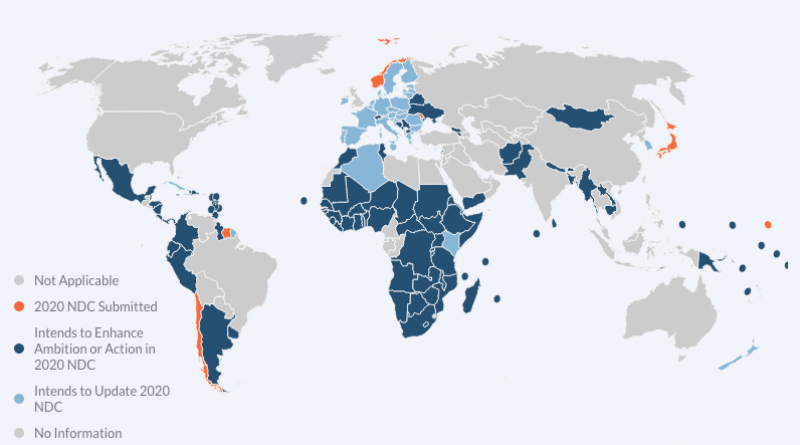Seven countries submit new 2020 national climate plans (NDCs).

Seven countries have submitted new NDCs so far, including the Marshall Islands, Suriname, Norway, Moldova, Japan, Singapore, and Chile.
Nationally Determined Contributions (NDCs) are countries' commitments under the Paris Agreement to reduce emissions and adapt to the impacts of climate change. In total, 192 countries submitted NDCs, making up 96% of global greenhouse gas emissions.
These nations pledged, as part of the Paris Agreement, to update their NDCs every 5 years. This year marks the 5th year since the signing of the agreement and therefore the first test of their intent to commit.
To date, 106 countries have indicated their intent to enhance their NDCs, but only seven have submitted new NDC policies so far. This represents just 2.8% of total global emissions.
In 2014, the majority (60%) of greenhouse gas emissions came from just 10 countries. In contrast, only 3% of GHG emissions were attributed to the 100 least emitting countries.The Marshall Islands are amongst these 100 countries. They represent only a small share of global emissions, nevertheless their ambitious efforts to significantly reduce this share plays a leadership role in promoting global climate action. The Marshall Islands are experiencing, first hand, the irreversible effects of climate change that threaten their very existence.
In November 2018, the Marshall Islands were the first country to submit an updated NDC, 2 years ahead of the UN’s planned COP26 in 2020. The revised NDC sets a new target to reduce emissions to 58% below the levels recorded in 2010 by 2035. The Marshall Islands have also reaffirmed their aspiration to become net-zero by 2050.
Norway is one of the more recent countries to announce new national climate plans. In February, they announced a top-line target to reduce emissions by at least 50%, with the ambition of reducing emissions 55% below 1990 levels by 2030. Previously, Norway had pledged a targeted 40% reduction in emissions by 2030. Norway is the first developed country to announce an enhanced NDC, paving the way for the rest of the world.
Norway has been demonstrating for years that it is possible to enhance the green economy. Their carbon price, at almost $60 per tonne, is one of the highest in the world. Since first implementing this carbon price in 1991, Norway’s GDP has more than tripled. Norway is also a global leader in electric vehicle sales. Fully electric vehicles accounted for more than 40% of all car sales in the country in 2019, which has helped spur its emissions reduction target.
The other five countries to announce revised 2020 NDCs include:
Suriname - they are actually carbon negative, as the country’s forest absorbs more GHG emissions than the country emits. They account for 0.01% of global GHGs. Suriname did not set a top-line emissions-reduction target; they instead focused on plans to move towards renewable clean energy. Suriname plans to power 35% of its electricity grid with renewable energy in 2030. They also plan to increase protected forests and wetlands areas to cover 17% of the country by 2030, up from the 14% specified in its previous NDC.
Moldova - they represent less than 1% of global emissions. The country announced an improved NDC in March 2020, with a new target to reduce emissions 70% below 1990 levels by 2030. Their previous NDC target aimed for a 64-67% reduction below 1990 levels by 2030.
Singapore - they announced an update of their first NDC in February 2020. They set a new intention to peak emissions at 65 MtCO2e by 2030. The country hopes to achieve a 36% reduction in Emissions Intensity (EI) from 2005 levels by 2030.
Japan - their newly submitted NDC is no stronger than the one submitted five years ago. Despite Japan’s status as a major global economy (and the world’s fifth largest greenhouse gas emitter), they are keeping in place a top-line target to reduce emissions 26% below 2013 levels by 2030. The Japanese have access to advanced technologies that make the possibility of pursuing a low-carbon future more affordable than ever. This underwhelming target contradicts the spirit of the Paris Agreement and fails to grasp the seriousness of the global climate emergency facing society today.
Chile - they announced, earlier this month, a strengthened and revised 2020 NDC. This new NDC includes a commitment to peak emissions by 2025 and cap emissions at 95 MtCO2e in 2030. They also set a GHG emissions budget of no more than 1,100 MtCO2eq in the period 2020-2030.
Chile made specific reference to the impacts of the current COVID-19 pandemic in their published NDC 2020 update:
“It is important to mention that Chile, like other countries, is facing a pandemic scenario due to COVID19. This situation may result in a health crisis demanding our attention and management. In this sense, our priority is overcoming that crisis and moving towards sustainable development with a pragmatic and crosscutting focus, holding human and territorial wellbeing at its core. The actions we take today, together with a just transition towards sustainable development, will define the type of society that we will build in the coming decades."
“Special attention has been paid to the afore-mentioned issue, which led to the incorporation of a specific social pillar focused on a just transition and sustainable development goals. This pillar guides the development and implementation of commitments incorporated in each component of the updated NDC.”
Since the signing of the Paris Agreement in 2015, economic opportunities for climate action have changed significantly. New technologies for climate solutions are cheaper and more accessible than ever before, and countries’ revised NDCs should reflect this.
Although the coronavirus pandemic has dominated governments’ attention around the world, it is pivotal that countries still submit their revised NDCs ahead of COP26, now due to take place in Glasgow next year. It will be interesting to see which countries follow Norway’s lead in ramping up the ambition that the climate crisis requires. Similarly, it will be interesting to see which countries fall short in their commitments to prevent a global temperature rise above 1.5°C.
20 April 2020
Climate Action




